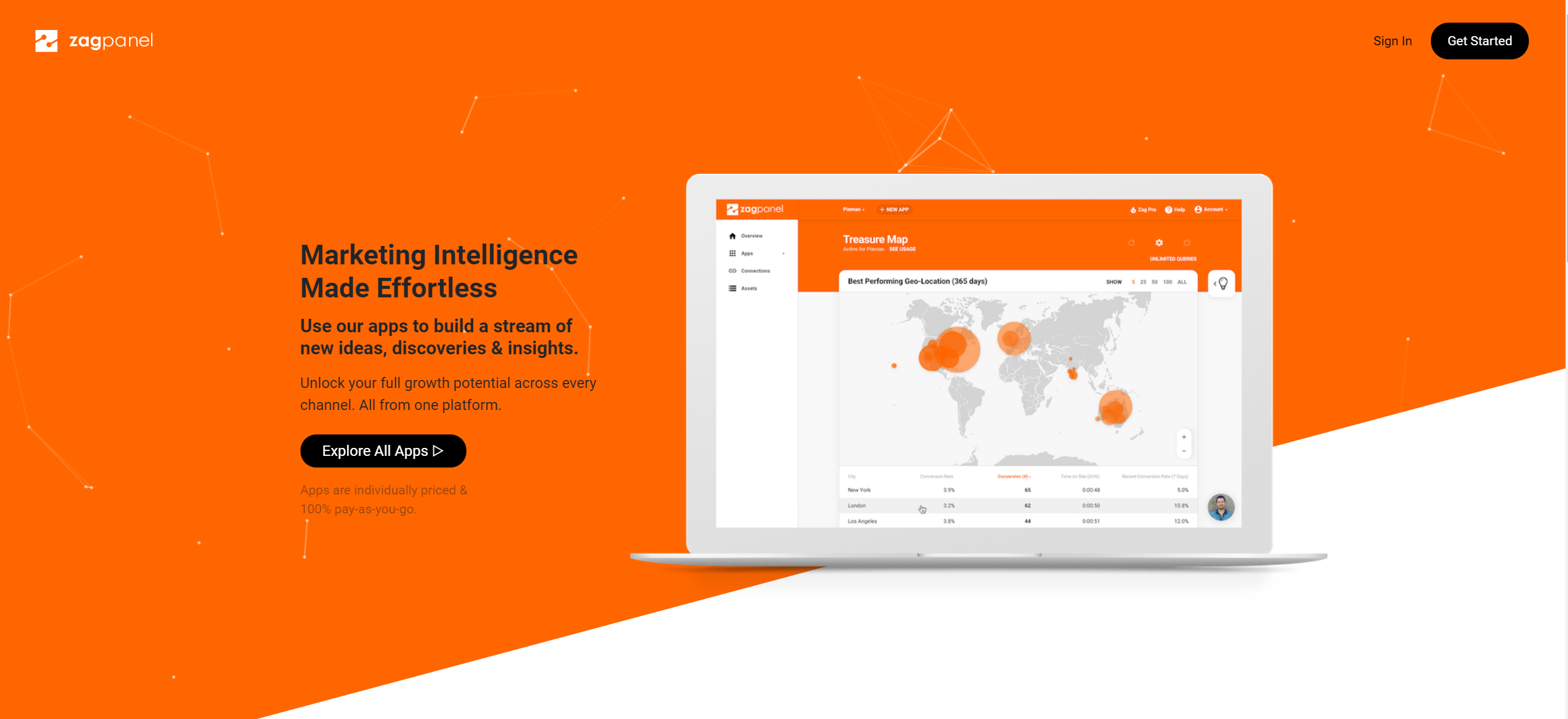Hey gang!
Good heavens – it has been a while.
For those who care, the preceding two blog posts (1, 2) provide somewhat of an update as to what the hell I’ve been doing for the past 3 years. So basically, if you’re my Mom, or the trying-too-hard insurance salesman who keeps sending me LinkedIn messages, see you back here in a few minutes.
For everyone else, let’s just dive straight in…
What follows is my “prediction” for what the digital traffic landscape will become over the next 2-3 years:
I say prediction in quotations, because this landscape already exists and is (by far) the fastest-growing segment of digital ad spend and marketing tech.
So it’s more a prediction as to how quickly it will hit critical mass, more than anything else. And anyone running paid traffic is probably already dipping their toes in the “future”, so to speak.
Anyway. Key up your imaginary drumrolls, because here comes the big reveal…
—
The Future of Traffic Generation is – Without Question – Intelligent Audience Modelling.
Now, let’s explore what that means exactly, and why you should care…
—
If you’re a clever little marketer, probably the first thing that popped into your mind just now was Facebook’s Lookalike Modelling capability. And you might be thinking to yourself that the author (yours truly) has truly gone off the deep end of irrelevance if he thinks this is somehow new… let alone “the future”.
What’s he gonna reveal next – posting on Squidoo?
Well, at this stage I may be the official hermit of internet marketing (fair enough), but the argument of today’s blog post is actually NOT that Facebook’s Lookalike Audience modelling is the penultimate apex of traffic generation.
Instead… my argument is that it’s just the primordial beginning.
And I believe this is strengthened by the fact that even in its early stages, Facebook’s ability to intelligently learn who its users are is what’s allowed them to successfully become the first actual contender to Google’s lofty throne – and in fact already unseating them in the battle for Mobile Display.
The key takeaway from that article being:
[alert style=”grey”]“…August 2012 was also the month Facebook made an inspired move with the introduction of Custom Audiences, anonymously matching advertisers’ first-party data like phone numbers and emails to users’ Facebook accounts for ad targeting. It would be hard to [overstate] the impact of Custom Audiences on digital advertising.
“Facebook quickly expanded Custom Audiences’ capabilities in 2013, first with the ability to expand targeting to Lookalike audiences, and then with the addition of consumer data from third-party vendors such as Datalogix, Epsilon, Axciom and BlueKai. Google only recently countered Custom Audiences and Lookalike Audiences with its version, called Customer Match, in the fall of 2015.”
Source: http://marketingland.com/google-stand-chance-facebook-mobile-display-171579
[/alert]
In other words: It wasn’t the size of Facebook’s audience that gave it the edge on Google… it’s what they could do with it.
Up until releasing Customer Match, Google only offered targeted traffic based on someone’s current session (what they searched, where they were browsing). Facebook offers targeted traffic based on who they are.
There’s a big difference – and folks, this is the new land race. But it’s not a race for clicks, views or shares.
It’s a race for user profile data.
Here’s what this looks like in a few years from now, and why conventional “traffic sources” are becoming irrelevant…
—
The Money is in the List… Right?
In the near future, this age-old marketing mantra is simultaneously never-truer and also completely irrelevant.
You could say it’s somewhat complicated. Let’s explore why, starting from the beginning.
—
Just over 10 years ago, when I had to somehow pay rent each month by selling enough of my skateboards online, my options for prospecting new customers were as follows:
* I could try to rank / compete on Google, Yahoo & MSN for popular keywords and wait to be discovered by my next self-qualifying customer (hopefully). Either organically or with PPC.
* I could list products on Ebay to reach consumers already directly in-market, and who might be actively searching for a new board at that time.
* I could buy ads or post specials in niche skateboarding sites/forums.
* I could broadcast something to my email subscribers.
And that’s about it. Of all those traffic strategies, it didn’t take long for me to realize that email marketing was where my “rent salvation” was most likely to be attributed.
Why?
Because unlike the other channels (search, marketplace, or media placements) – I wasn’t relying on an average conversion rate from a fixed daily volume of available traffic. Rather, I could “tap” my total accumulated audience on-demand, where my reach was instantaneous and limited only to the size of my list. And to top it off, list traffic converted like no other, and was essentially free… once you built it.
That is why the old mantra rang true for the majority of businesses trying to sell online. Email marketing allowed you to build your own prospect pool, and then push them down the product funnel whenever you wanted.
So, naturally the smart play was to grind out the necessary struggle for traffic in the beginning to build your list as large as possible – after which you only had to occasionally run paid traffic to counteract your attrition (unsubscribes), when necessary. This process took several months, at the least.
Today, email remains a critical CRM channel for most brands. And yes, there’s still plenty of money in the list. But unlike times past… it’s no longer considered the ultimate traffic source.
And that’s not because email was somehow usurped by another traffic channel… but rather because getting traffic is no longer the “hard part”.
Even just a few years ago, driving traffic was all about setting up multiple streams of visibility – where enough individual trickles might just add up to a sizeable flow of activity. (One day).
But today, with the ascendancy of Programmatic & Facebook Ads having aggregated the entire internet & app ecosystem into a centralized inventory pool – literally anyone can walk right up to the internet’s proverbial fire hydrant, clamp on a hose, and drive a massive torrent of traffic – instantly.
And with the right audience data (or data-derived targeting algorithm) to stack on top of that 2+ billion user audience – these are visitors who can be every bit as targeted and “in-market” as the ones you previously had to earn through months of writing content, begging for backlinks, or aggressively competing to acquire (search by search) with Adwords.
In short, list-building is no longer really a traffic source so much as it’s a CRM asset, a targeting tool, and a segment of your overall 1st-party data.
However, the money is still in the “list”, of sorts. But properly utilizing your list for targeted traffic is now a different process.
Because in today’s marketing landscape – where you can snap your fingers and reach 98% of internet users instantly – the challenge is no longer in driving traffic. The challenge is in figuring out how the hell to filter it into profitable audience targets.
Which brings me to the future of traffic…
—
Show Me Your “One in a Million” Customer…
…And I’ll Find You a Million More. Instantly.
Sincerely,
~ Every Self-Respecting Ad Platform in 2 Years
—
For most people, their marketing data (analytics) is basically just a barometer.
“Oh, looks like traffic is up this week, and sales seem good. Sweet.”
The slightly more serious users view their data as a source of insights about prior events. It’s a way for them to react to things that already happened, and perhaps to inform smarter decisions.
Sophisticated marketers are using their data to create direct ad targeting segments (retargeting) in tandem with their CRM strategy (rules-based marketing automation). Most brands with a half-decent marketing department are utilizing 1st-party audience targeting & CRM, at least to some extent. And basically, this just amplifies the impact of whatever they’re doing to drive first-click traffic (aka: prospecting).
But the really sophisticated marketers are also using their data as a primary traffic source – massively expanding their prospecting reach, and effectively multiplying their TAM (total available market).
Right now today, FB’s Lookalike Audience feature is the best vehicle for doing this. With as little as 100 connected emails / phone numbers, Facebook can build you a targeted audience into the millions. Even in “small” niches. This is truly game-changing.
But it’s not the only game in town… and it sure as hell won’t be the last.
Make no mistake: The traffic source of the future is algorithms.
Algorithms – or if you like, Intelligent Audience Models – that take seed data (yours), and with that “seed”, build massive profile-matched segments across the entire effective internet user base. A user base that’s instantaneously reachable with programmatic advertising across the aggregate publisher networks, including Google & Facebook’s inventory.
And yes, while there’s a few options for audience extension already – these algorithms are in their infancy. They will continually improve, and probably verticalize (become industry-focused). As with Facebook, it’s going to start with the major publishers (who already have access to massive stores of their user’s data), but I believe we’ll see an entire category of Ad Tech emerge in the very near future – where the sole purpose of these platforms will simply be to create various types of targeting logic from your existing data.
Eg. “Go find 1 million prospects that match the profile of my top 100 fastest-converting customers to-date, but who’ve never been exposed to my brand.”
And things will get really exciting when these Audience Models start effectively blending in accurate 3rd-party data.
Eg. “Go find 1 million prospects that match the profile of my top 100 highest-LTV customers to-date, who also earn more than $150K annually, and who actively use their FitBits.”
Yes, the effectiveness thereof depends on the accuracy of this additional targeting data (3rd party) – as well as the participation of the data providers (FitBit, in this hypothetical example) – but as data increasingly becomes more and more of a saleable asset in the programmatic ecosystem, the volume of 3rd-party targeting layers will only increase in abundance & accuracy.
In theory, you can sort of do this already. Most DSP’s integrate 3rd-party data profiles from companies like Exelate, BlueKai, etc. But it’s not really all that effective yet.
This is changing, though – and it won’t be long until the EPC’s from 3rd-party data consistently exceed conventional placements.
Ultimately, what this means is that in the very near future, the vast majority of your traffic generation will be the metaphorical equivalent of Professor X scanning the global populace, and pinpointing all of your most promising prospects (on the planet) in a matter of seconds.
Well… so long as your market exists 😉
—
So… What Does it All Mean (For You)?
If we’re finally witnessing the fabled era of centralized & unlimited push-button traffic, across every channel & device – traffic that’s far more targeted than ever before…
…is there any opportunity here for “little guys” like us, aside from early adoption?
—
The opportunity for anyone who’s properly grasping the implications of using instantaneous, algorithmic targeting across the entire connected web (PC’s, mobile, IOT, etc.) that’s seeded by your own customer data (your list)… is truly staggering.
In simple terms, what this means is that your capacity to scale any viable business to critical mass is now no longer limited by time, nor is it limited by access.
Reaching the majority of your entire available market is now something that you could literally accomplish inside of 24 hours. And the scale & precision of which you can do so will only continue increasing, as the various matching algorithms improve, and as the ecosystem of 3rd-party data expands.
As a result, my prediction is that in the early days (the next 2-3 years), early-adopting marketers will find themselves with virtually limitless targeting capabilities. And combined with the sheer scale of inventory – CAC’s that mirror the early days of penny-click Adwords. Good news for the lazy… at least in the short term.
But inevitably, in time, the moat will widen as demand begins to catch up with supply. (Or as the data vendors figure out how to inflate costs relative to targeting – whichever comes first).
So as I see it, here’s the best way to cash in on the emerging bonanza – as well as thriving well into the future as the new world of algorithmic traffic matures…
1) Start Collecting As Much Customer & Conversion Data as Possible.
This goes beyond just dropping cookies (retargeting audiences – which is still definitely something to start doing yesterday, also). You want as many end-points as possible across your entire userbase.
Emails, addresses, phone numbers (especially mobile), Twitter handles, attribution data… everything. You want to do this so that you can start linking your marketing results to real people.
And you want a variety of data-points to increase the likelihood – and accuracy – of audience filters & algorithmic profile-matching.
This is the new “list”.
The more data you have on your customers… the more customers you can find.
(Something, something, metaphor regarding “it takes money to make money”).
2) Start Experimenting With Existing Tech.
Obviously, start using Facebook’s Lookalike capabilities. Do this yesterday. Use different types of accepted data, and see which customer segments drive the best results with FB’s current algo’s.
Then, branch out into the emerging alternatives. Here’s a few to try out:
* Twitter’s Tailored Audiences
* AddThis’ Custom Audiences (you’ll need a DSP/DMP to activate)
Just start running traffic, and see what types of data (and parameters) works best for each platform. The sooner you get started, the more of a head-start you’ll have on this as better tech, and better platforms, continue to emerge…
And lastly:
3) Get Positioned to Actually Make the Most of This. ASAP.
In simple terms, here is what you need:
* A scalable business model where you actually collect (and own) your customer data.
Yes, I realize “the Amazon model” is fun and exciting. But you have very limited data assets, and you’re ultimately just a supplier for Amazon. Consider pivoting to an E-comm model under your own brand, domain, traffic channels, etc.
Similarly, affiliate marketing is wonderful for (temporary) cashflow. Well, at least when you manage to hit a home-run. But just like the Amazon model, you’re flying blind in terms of data.
(Not to mention, it’s generally a zero-equity business… but that’s a whole other blog post).
And lastly, ensure that you’re not too niched-up. Your top competitors should have thousands of active customers.
Or alternatively, if you’re an agency or consultant – get clients who match this profile.
* A funnel that turns a profit with paid traffic.
I won’t pull any punches on this. If your business model doesn’t run profitably with paid traffic, then first of all – why are you wasting your time?!?! – and secondly, just figure out how to make it work. Period.
Fix your conversion rate with split-testing and if need be, by hiring copywriting talent. Raise your LTV with upsells, improving retention, testing prices, testing various CRM & marketing automation tactics… etc.
There’s a billion resources and tools out there that will simplify and guide you through this process.
Is it fun? No. It sucks. This is the worst part of the entire process, because you have to essentially be willing to run at a controlled failure-rate, all the while scrambling to solve the “profit puzzle”.
But once you DO turn the corner (and with enough persistence and – chiefly – the willingness to adapt), then your capacity to scale will only be limited by internal bottlenecks.
* A CRM and/or data management platform
Google Analytics won’t cut it, because they won’t let you connect user sessions to PII (identifiable information). Which is essential if you plan on extending your data beyond the walled-garden of Google’s ad eco-system.
You need to be able to create valuable segments from your existing leads & customers – as well as collect & store as many datapoints as possible.
Again, there’s a number of options out there that will fit the bill for this, or at least mostly fit the bill. Examples include Ontraport, InfusionSoft, and even autoresponders like Aweber (to an extent).
The key here is to be able to quickly export customer data by filters like: Biggest spenders, recent converters, customer type… etc.
——————————-
Bottom line – your list is more than just your list.
In the new age of Hot Models as the traffic source – your “list” is the entire powerplant. And its horsepower is determine not by its size per se, but rather by the amount of end-points you’ve collected, and the creativity of your “seed segments”.
Get good at this now – while this tech is still just an infant – and you’ll be unstoppable by the time it’s fully grown in the next couple years.
——————————-
Well folks?
I think that’s it for this one.
While I do have somewhat of a dog in this fight (Intelligent Modeling), it’s still too early-stage to introduce at the moment.
So for the meantime, I suppose you’ll just have to settle for my ramblings, sans agenda. (I know, crushing.)
Thoughts on this? Questions?
Are you experimenting with lookalike targeting already?
Are you curious about the airspeed velocity of a laden swallow?
Feel free to post a comment below, and I’ll definitely reply back before 2017.
Cheers
~ Chris





Hear hear!
So good -> “Is it fun? No. It sucks. This is the worst part of the entire process, because you have to essentially be willing to run at a controlled failure-rate, all the while scrambling to solve the ‘profit puzzle’.”
It’s fun watching facial expressions when I explain this message to clients.
We must have a lengthy convo on intelligent audience modelling in the near future.
Definitely Filip!
You’re coming to BC again this December, right?
Regardless we should catch up soon!
Chris
Welcome back, old friend! Missed your informative sharing, Chris.
Hi Chris – good to hear from you again. Great post – always good value from you!
One of the greatest posts , i have read in a while! thanks
Great post Chris, good to hear from you which laden sparrow are yiu refering to eastern or western?
I’m not sure!! Lol
Funny that I received an e-mail from you today roughly a week after I visited your old website searching for a post you wrote regarding the future of marketing being directory sites.
I’m not one who believes in coincidences or accidents so I guess this is the universe telling me to take action on what you’ve written here.
Will digest further once I get home. Thanks for the info!!
-Ray
Ah, yes – the pre-Panda days. (When building content with data-driven ad-lib was a goldmine).
From the SEO perspective, I was technically right at the time. But then an algorithm – Panda – killed that model. So ironically, we’re both full-circle, thanks to AI 🙂
Good to hear from you, Ray.
First, the important part, since that’s one of the best movies ever … would that be an African or European Swallow?
Second, it’s great to hear from you again, always love your deep thoughts. It had been so long, I wondered if you were preparing to launch a SpaceX competitor or something equally epic.
Really good stuff, and I think you’re definitely on track with this.
To your question, I’ve known about FB and Google’s list abilities since they launched, and have used them both for clients to great effect. But it was hard enough getting an email or phone number list from them, much less “all” the customer data.
As we grow our own venture though, with tons of our own data on clients and prospects, there’s some really cool stuff that can be done – you’re absolutely right.
At this point, we’re looking for tools to help make this easier as we grow – it’s early and small and manageable in a manual fashion right now. But that won’t be the case for too long.
So between the best CRM that we ultimately decide on and Zapier, we have all kinds of cool things planned for automatic adjustments and optimization that connect to AdWords scripts, and other fun stuff.
Anyway, sorry to ramble, but you asked. 🙂
I do think that learning as much as possible, as soon as possible, is what the smart marketer should be doing right now. And maybe for those enterprising types, to develop tools and training and stuff to make this more digestible to the non-ninja types.
Thanks, Chris, always a pleasure.
Scott
Scott, thanks so much for chiming in!
Agreed on the limited facilitation tech, at the moment – not many people have an extra $150K lying around (just to onboard) into the average DMP.
Oh – and regarding the most important question: “What?!! I don’t know that! Aaaahhhhhhhhh…” *gets thrown into the sky*
Been a while but I must say it is nice to hear from your brain again. Always out in front of the mob, which is where you need to be in today’s noise, if you want to be heard.
It’s a new world emerging and as you point out, contains and new and interesting challenge…
IAM is definitely having the fish come to your net on the back of your boat sitting in the harbour, while you figure out how to get them out of the net, off the boat, ice-boxed and to market asap.
Thanks so much Greg.
Agreed, the way we “fish” is changing categorically. It’s no longer about casting a net out. It’s about building the best method of “fish-sorting” so that the right ones land in your boat.
Nice post man, added to my Twitter q 🙂
Thanks!
First off good to hear from you again Chris. You’re one of the few marketers online that I actually have a folder with your name to store your emails and I STILL have it. 🙂
Does this impact local small business owners in any way and if so how do you see that change taking place for them? Right now getting found in Google Maps for local businesses is the golden goose, but will this movement toward Intelligent Modeling change that?
Thanks Stephen!
For local marketing, I’d say it actually depends on the industry. For “need it now” marketing (flower shops, restaurants, glass repair, etc.) search is still king, for obvious reasons.
But for clients like dentists, spas, car dealerships, high-ticket retail, financial… etc. it’s basically the same as if you’re running buys for a national brand. You can just filter it down to geo-target.
Currently, FB Ads for local biz’s is insanely effective, even with basic demo targeting. Lookalikes will probably be a worthy pursuit for high LTV customers that match a certain intent. Eg. High earners that also spend big, and buy new German cars, tend to be “friends” – so a lookalike would be an effective targeting map in this scenario, even for local-specific.
So in summary: It depends.
Lookalike modeling is definitely more conducive to discretionary purchases, no question. But even for “as-needed” business models, audience data can still drive great ROI’s.
For example, Chango and Ad.net can reach prospects who’ve *historically* searched for a given keyword. Someone searching for an as-needed service (eg. glass repair) may very well still be in-market on Thursday if they were searching on Wednesday.
Similarly, lookalike modelling can be effective here as well – particularly with predictive models. Someone who’s buying pregnancy test kits 9 months ago is a very good candidate for local baby retailers.
This is how local marketers can greatly expand the scale of their client’s reach, even at the geo-targeted level.
Hope this helps!
Definitely exciting times to be in! But at the same time, despite all the tech, the majority still won’t be able to figure out craft an offer, write ads that convert, set pixels, run a split test, and all the other intricacies. So, it’s an exciting time to be a capable direct response marketer.
Also, glad to see you switch to paid traffic 🙂
Agreed 🙂
It’s basically capable DM’s vs Fortune 500’s (and their army of agency suppliers).
Plenty of room for all of us 😀
What do you mean? An African or European swallow?
Thanks Chris I found your article an interesting read and quite humour oud at times! I found it particularly pertinent as I have just launched my first paid advertisements on fb so it’s all still in the experimental stage… Here’s hoping it goes well and I learn some tactics along the way.
Astrid
Well, you have to know these things when you’re a king, you know
Oh my Chris, I thought you died! 😉
Always enjoy reading your insights and take aways. I work for a national nonprofit organization and you better believe that modeling with PII is what drives revenue in philanthropy. I’m geeked for all the new tools and databases emerging.
Thanks!
The rumours of my death were highly exaggerated 😉
That’s an interesting perspective, re: Nonprofit. For sure PII would be critical for targeting.
I might ping you one of these days to dig into that a bit, I have zero marketing experience in the nonprofit / NGO sector.
Wow. Extremely useful…and incredibly overwhelming..all at the same time! I know nothing great is easy, but for someone who just casually wants to build a little blog with nice side income, almost seems impossible. Not impossible conceptually, but hard practically. Not making excuses, just stating facts. Regardless, thanks for your excellent insight!
Hi Kris, I hear ya.
It’s a “big” topic, for sure. And at the moment, possibly out of reach for certain entry-level startups or small publishing models.
But that won’t always be the case. Retargeting was an advanced strategy for years before it was made “mainstream” by companies like AdRoll.
The same applies here – audience modelling across the ecosystem will eventually become user-friendly enough to where the majority of marketers will see it as being a “given”, much like MailChimp or Aweber.
At that point, it might make more sense to dive in.
Cheers!
-Chris
Glad to hear from you Chris! Thanks for great information Again ! Blessings to your growing family!
Nice to see you back, Chris. I’ve missed hearing from you. And thanks. This article was exactly what I needed, exactly when I needed it.
“Scott Harvey
First, the important part, since that’s one of the best movies ever … would that be an African or European Swallow?”
The secret answer is “Vorpal bunny.”
And the two big life tips from Monty Python are “never be a troubadour” and “no one expects the Spanish Inquisition.”
Hey Chris,
Welcome back to the new world of I/M!!!!! You’ve got a PHD in marketing now, and it’s right on the money. Let me know what you’ve got going, OK?
Thanks Lee
Will do, thanks!
Ah, i see. Well th’tas not too tricky at all!”
Hi Chris.
Pleased you’ve done a Lazarus. Really missed your marketing insights, coupled with your quircky humour (I’m English, hence the “u” in humour.)
Does the mention of “A CRM and/or data management platform” mean you’re working on a solution?
Catch you later.
Paul.
Thanks Paul! As a Canadian, I quickly recognized “humour” as the correct spelling 🙂
Re: DMP/CRM, the answer is sort-of. More along the lines of a DMP, and less-so a CRM. (Already plenty of CRM’s. DMP’s are currently only used by larger brands and have a high barrier to entry).
It’s a big project, and will have to be built in stages. Not exactly a launch 😉
I’ll keep everyone posted though.
Chris – I bought many of your Lazy products back in the day. I did well for a long time, but got a little lazy there for awhile, so trying to step it back up. I read this a couple months back and just came back around to see if you had any updates / announcements. Excited to find out what you have cooking.